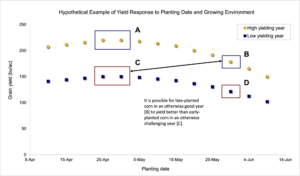Corn Growth and Development – Are we behind?
This article originally appeared in the AGVISE Laboratories Fall 2022 Newsletter under Southern Trends
The spring and early summer were very interesting to say the least. Spring rains continued well into late May and delayed planting for sugar beet, corn, and soybean throughout the southern region. By mid-May, many producers changed long-day corn maturities to earlier corn maturities. In the Benson, MN neighborhood, corn planting finally got underway around May 20 (60% planted) and near completion on June 5 (93% planted). Around the coffee shop, many people have commented, “How far behind is the corn crop in 2022?” So, let’s put some numbers to this question.
The High Plains Regional Climate Center has a nice growing degree day (GDD) calculator for simulations of corn growth and development (https://hprcc.unl.edu/agroclimate/gdd.php). I made a few GDD simulations for previous years, comparing 2022 with 2019 (a below-average GDD year) and 2021 (an incredible GDD year). As of mid-July, the 2022 growing season was 3 days ahead of 2019 (63 more GDD) and 9 days behind 2021 (182 fewer GDD). A corn plant takes about three days to make a new leaf when the corn plant is V12 and younger, so you can guesstimate that we were about 3 leaf stages behind 2021.
With the late spring planting window, many corn producers around Benson, MN opted for corn maturities about 6 to 8 days earlier than normal. If you compare an earlier 92-day corn maturity with a more typical 100-day corn maturity, the required GDD to blacklayer is 2207 and 2401 GDD, respectively. We generally accumulate 20-30 GDD per day in midsummer. If either corn maturity was planted on May 20, the estimated silking (R1 stage) date is July 21 for the 92-day maturity and July 25 for the 100-day maturity, a difference of four days. Similarly, the estimated blacklayer (R6 stage) date is September 18 for the 92-day maturity and October 12 for the 100-day maturity, a difference of 24 days. Toward the end of the growing season when fewer GDD are accumulated per day, the difference in maturity groups really starts to show. Warmer than average temperatures will shorten that difference, but only time will tell if the right decision was to plant earlier corn maturities.
Nielsen, R. L. The Planting Date Conundrum. Corny News Network, Apr. 2022. Purdue Univ., West Lafayette, IN. https://www.agry.purdue.edu/ext/corn/news/timeless/pltdatecornyld.html
To help drive home the point about planting date and final corn grain yield, I really like the graph from Dr. Bob Nielsen at Purdue University (figure above). Early planting does not always result in very high corn yield, and late planting does not always result in very low corn yield. In 2022, late planting will limit top-end crop yield potential, but the final crop yield could still be good as long as GDD accumulation remains above average. As always, Mother Nature will be the final determinant in setting the final crop yield.

